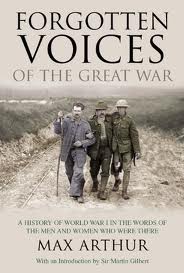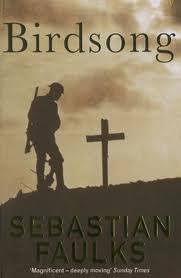Birdsong has completed its two episodes on the BBC. Author, Sebastian Faulkes tells us of a story about a soldier who has been affected by the experience of war; from the battles of the Somme to Messines Ridge and Amiens. The more the battles rage the more his mind is taken back to a time when he fell in love with a French woman in the summer of 1910. The story weaves its way through the deaths of comrades on the battle field and the memories of the loss of his lover before the war changed his life and that of many others. It also delves into the experiences of a group of miners who are tunnelling under the ground taken up by German trenches. The book presents a far darker picture of the experiences of the mine workers than we have seen from its televised counterpart, which naturally tends to emphasise the story’s love theme. However, the BBC still manages to tell the story of the mines, a little known, but very important part of the war’s operations. The chalk deposits that lay around the Western Front, provided a relatively penetrable subsoil and below the streets of Arras, the town’s besieged residents have hidden in the honeycomb of tunnels for hundreds of years. Le Grande Mine site at La Boiselle shows a huge crater from an underground bomb which announced the start of the Battle of the Somme on July 1st 1916. The placement under the German lines, was the result of the tunnelling of miners taken from the coalfields of England and Wales and even workers from the London Underground.
Historian Max Arthur, produced a magnificent book titled ‘Forgotten Voices Of The Great War’ and tells the story of the war via the memories of the soldiers who were actually there. One such soldier was Lance Sergeant Charles Quinnell of the Royal Fusiliers (9th Battalion). He tells us of his observations of the miners and finishes off with one of the war’s many shocking revelations.
“Sixty men and two senior NCO’s out of each battalion had to be labourers for the Royal Engineers mining parties.
We were billeted in French barracks in Bethune and the idea was that three parties of thirty men would attend to each mine. There were three mines at Givenchy, known as Ducksbill 1, Ducksbill 2 and Ducksbill 3.
As you walked along the trench all you saw of the mine was a wooden framed doorway about four feet high and two wide. Behind it was a staircase that went thirty feet underground and opened up into a room about eight feet by eight. In the centre of that room was a four feet square shaft and over the top of that was a wooden windlass and a rope. The shaft went down another twenty feet or so. At the bottom of the shaft was another doorway facing the German Lines and that was the entrance to the tunnel. The tunnels were a continuation of this wooden frame work that went straight ahead under the German lines.
Now these lads were really masters with their tools. Their principal tool was a bayonet and they would stick that into the face then with a twist of the wrist bring out a big cheese of clay, which was put in the sandbags and passed along the tunnel to the bottom of the windlass. That was then wound up and an endless chain of men took them up the staircase and threw them over the top.
Every now and again we’d have to stop work and we’d always have one man down there at the face who’d sit on a sandbag with a stethoscope pressed against the wall, so he could hear the Germans working. If you could hear the Germans working you knew you were safe, it was when he didn’t hear a noise you knew the Germans were going to blow. One day I crept up to the chap who was listening and whispered, could I have a listen? He handed the stethoscope to me and I could distinctly hear the Germans talking.
It was clay there and while those timber frames were good, every joint leaked and as you were bending down all the time and they were only four feet high – your back got absolutely sodden because it was drip, drip, drip on you all of the time. We pumped the mine for days on end but you couldn’t make an impression on the water. The bottom tunnel was absolutely filled and it started to come up the shaft. This puzzled the Royal Engineer officer who went out one night and found a crater immediately above the tunnel. The German had been pumping water out of their mine and into this crater, so of course we were getting the full benefit of it. So he cut the German hoses and that had an immediate difference and we got our mine clear of water.
The miners were a rough lot, but by God they were brave men. They used to mooch into the trench, they had a rifle but they didn’t know how to fire it. They weren’t supposed to, they were miners. You could always tell a miner, he never bothered to clean his buttons. He was a miner, he wasn’t one of those posh soldiers.
We had a sergeant who came to us when the Dardanelles was evacuated, a very regimental type of man. On his first day in the trenches two of these miners slummocked past him along into the front line – they used to walk along with their heads down and took no notice of us and we took no notice of them. Anyway, this sergeant didn’t know who they were and yelled out “Halt !” Then when they didn’t attempt to halt, he gave the order again, but when they didn’t obey he brought up his rifle and ‘bang’, he shot the first one through the head. Then he did exactly the same to the other man, so a bullet went through both their heads. He killed them stone dead. He was later court martialled and reduced to corporal”.

